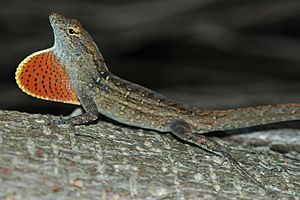Jacmel gracile anole facts for kids
Quick facts for kids Jacmel gracile anole |
|
|---|---|
 |
|
| Conservation status | |
| Scientific classification | |
| Genus: |
Anolis
|
| Species: |
marron
|
The Jacmel gracile anole (scientific name: Anolis marron) is a small, fascinating type of lizard. It is also known as the Jacmel anole. This lizard is part of a large group of reptiles called Dactyloidae, which includes many different kinds of anoles. You can only find the Jacmel gracile anole in one special place: the country of Haiti.
Contents
What is the Jacmel Gracile Anole?
The Jacmel gracile anole is a specific kind of lizard. It belongs to the Anolis genus, which has over 400 different species! These lizards are known for being very agile and quick. They often have long, slender bodies and tails.
Where Do They Live?
The Jacmel gracile anole is endemic to Haiti. This means it lives naturally only in Haiti and nowhere else in the world. Haiti is a country located on the island of Hispaniola in the Caribbean Sea. Anoles often live in warm, tropical places. They can be found in forests, gardens, and even near human homes. They like places with lots of trees and plants to climb on.
What Do Anoles Eat?
Most anoles, including the Jacmel gracile anole, are insectivores. This means their main diet is insects. They love to eat things like crickets, spiders, and other small bugs. They are very good hunters. Anoles will often sit still and wait for an insect to come close. Then, they quickly dart out to catch their meal.
How Big Are They?
Anoles are generally small to medium-sized lizards. The term "gracile" in their name suggests they are slender and delicate. While the exact size of the Jacmel gracile anole isn't given, most anoles are only a few inches long. This small size helps them hide from predators and move easily through dense plants.
How Do Anoles Reproduce?
Like many reptiles, anoles reproduce by laying eggs. Female anoles usually lay one egg at a time, but they can lay several eggs over a breeding season. They often bury their eggs in soft soil or leaf litter to keep them safe. After a period of time, tiny anole hatchlings emerge from the eggs. These young anoles are miniature versions of the adults and must quickly learn to find food and survive on their own.
Interesting Anole Facts
Anoles are known for some cool abilities. Many species can change their skin color. They do this to blend in with their surroundings, which helps them hide from predators or sneak up on prey. They also change color to communicate with other anoles. For example, a male anole might turn a brighter color to show off to a female or warn another male to stay away.
Another interesting feature of many anoles is their "dewlap." This is a flap of skin, usually brightly colored, located under their throat. Male anoles often extend and retract their dewlap to attract mates or defend their territory. It's like their own special flag!
Anoles also have special pads on their toes. These pads have tiny hairs that help them stick to smooth surfaces. This allows them to climb walls, tree trunks, and even glass windows with ease. It's like having built-in sticky gloves!
Images for kids



